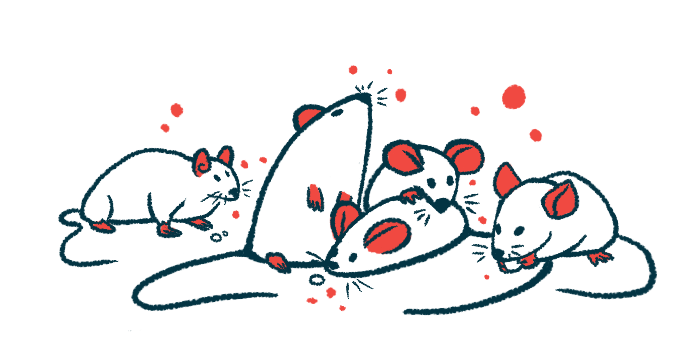Retinoic Acid Treatment May Ease Fragile X Social Deficits: Mouse Model
Natural vitamin A byproduct found to restore social behaviors in mice

A month of treatment with retinoic acid — a naturally occurring byproduct of vitamin A — was able to restore certain social behaviors in a mouse model of fragile X syndrome, according to a recent study.
The molecule likely restored the behaviors by normalizing levels of certain genes in the brain, data suggested.
These findings add to previous studies that demonstrated the therapeutic potential of retinoic acid in models of autism spectrum disorder (ASD), a condition that has considerable overlap with fragile X.
Moreover, they “shed light on the possibility of [retinoic acid] treatment in [fragile X] and ASD patients in the future,” the researchers wrote.
The study, “Retinoic Acid Supplementation Rescues the Social Deficits in Fmr1 Knockout Mice,” was published in Frontiers in Genetics.
Retinoic acid is derived from retinol, also known as vitamin A, which is supplied to the body from dietary sources like cheese, eggs, and oily fish.
The vitamin byproduct is critical for brain health, including nerve cell development and cell-to-cell communication. An increasing number of studies have identified retinoic acid as potentially therapeutic for a range of diseases, including leukemia, skin disorders, and Alzheimer’s disease.
Retinoic acid a possible fragile X treatment
In cell models of fragile X, retinoic acid-mediated regulation of nerve cell communication is disrupted. Retinoic acid production and signaling also were diminished in a mouse model of ASD, and supplementation of the nutrient improved behavioral problems associated with the disorder.
Given that ASD and autism-like behaviors — including impaired social skills and stereotyped, repetitive behaviors — are common symptoms of fragile X, researchers wondered whether retinoic acid might also be therapeutic for these patients.
In a cell culture model of fragile X, researchers found that low levels of FMR1 — the gene whose mutations are responsible for fragile X — were associated with reduced retinoic acid signaling.
The team then examined whether treatment with the nutrient was therapeutic in a mouse model of fragile X called the Fmr1 knockout model. Mice were given oral retinoic acid daily for one month and then tested for autism-like behaviors.
As expected, Fmr1 knockout mice exhibited social deficits compared with healthy mice, which was measured using a test called three-chamber social interaction.
Normally, when given the choice between interacting with another mouse or an inanimate object, mice prefer the other mouse (sociability). If instead offered a choice between interacting with a new mouse or a known one, they prefer the new mouse (social novelty).
When presented with these options, Fmr1 knockout mice did not show these preferences, indicating social deficits. Retinoic acid treatment was able to rescue the atypical social novelty behavior, but not the sociability behavior, compared with untreated Fmr1 knockout mice.
Mice also were tested for repetitive behaviors, which are excessive in ASD. However, the Fmr1 knockout mice did not exhibit more of these behaviors than healthy mice, and retinoic acid had no effect.
Other behavioral abnormalities also were tested, specifically hyperactivity and motor coordination. The fragile X mice exhibited hyperactivity, which was unaffected by retinoic acid treatment. Motor coordination was normal regardless of treatment.
To explore the mechanisms by which retinoic acid acts, the researchers examined levels of genes that may be altered in the brains of treated mice. They examined a brain region called the prefrontal cortex, which is involved in regulating social behavior.
A total of 56 genes were identified that were disrupted in Fmr1 knockout mice compared with healthy mice, but were restored to more normal levels with retinoic acid treatment. This group included genes known to be linked to autism and brain function.
Overall, the genes were mostly involved in pathways that have already been implicated in fragile X, including metabolic processes, memory, cognition, and the network of proteins, called the extracellular matrix, that gives cells support.
“Collectively, these results suggested that [retinoic acid] alleviated defective social novelty behavior in Fmr1 [knockout] mice possibly through restoring anomalous expressed genes and biological processes to normal,” the researchers wrote.
“Although many questions remained to be addressed, our findings … provided a potential therapeutic intervention for [fragile X], which may further be used in other disease models with defective [retinoic acid] signaling,” they wrote.
The team noted that retinoic acid has been used to treat other diseases. Thus, its safety has already been established. Synthetic versions of the molecule also have been designed to help it better reach the brain.






